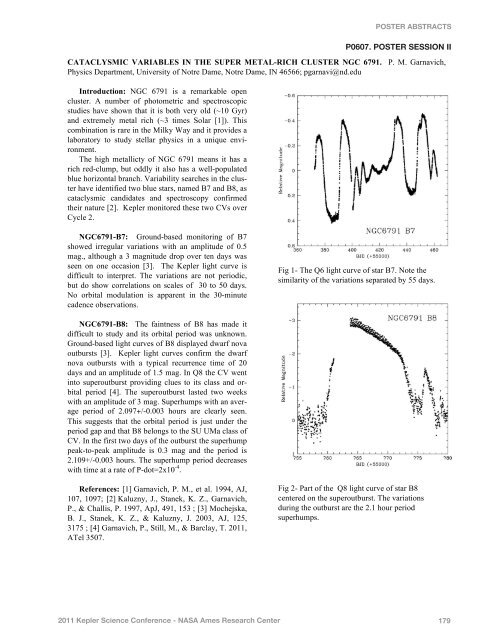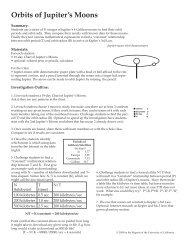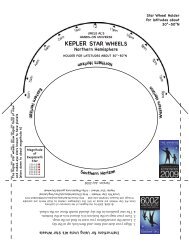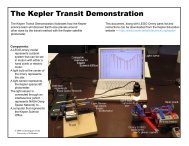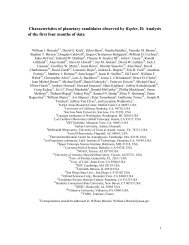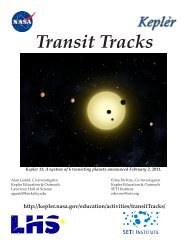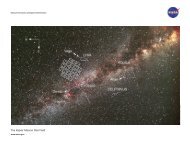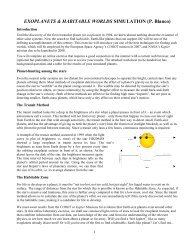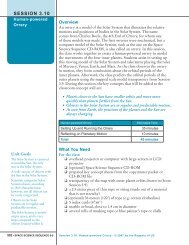Poster Abstracts - Kepler - NASA
Poster Abstracts - Kepler - NASA
Poster Abstracts - Kepler - NASA
- No tags were found...
Create successful ePaper yourself
Turn your PDF publications into a flip-book with our unique Google optimized e-Paper software.
POSTER ABSTRACTSP0607. POSTER SESSION IICATACLYSMIC VARIABLES IN THE SUPER METAL-RICH CLUSTER NGC 6791. P. M. Garnavich,Physics Department, University of Notre Dame, Notre Dame, IN 46566; pgarnavi@nd.eduIntroduction: NGC 6791 is a remarkable opencluster. A number of photometric and spectroscopicstudies have shown that it is both very old (~10 Gyr)and extremely metal rich (~3 times Solar [1]). Thiscombination is rare in the Milky Way and it provides alaboratory to study stellar physics in a unique environment.The high metallicty of NGC 6791 means it has arich red-clump, but oddly it also has a well-populatedblue horizontal branch. Variability searches in the clusterhave identified two blue stars, named B7 and B8, ascataclysmic candidates and spectroscopy confirmedtheir nature [2]. <strong>Kepler</strong> monitored these two CVs overCycle 2.NGC6791-B7: Ground-based monitoring of B7showed irregular variations with an amplitude of 0.5mag., although a 3 magnitude drop over ten days wasseen on one occasion [3]. The <strong>Kepler</strong> light curve isdifficult to interpret. The variations are not periodic,but do show correlations on scales of 30 to 50 days.No orbital modulation is apparent in the 30-minutecadence observations.Fig 1- The Q6 light curve of star B7. Note thesimilarity of the variations separated by 55 days.NGC6791-B8: The faintness of B8 has made itdifficult to study and its orbital period was unknown.Ground-based light curves of B8 displayed dwarf novaoutbursts [3]. <strong>Kepler</strong> light curves confirm the dwarfnova outbursts with a typical recurrence time of 20days and an amplitude of 1.5 mag. In Q8 the CV wentinto superoutburst providing clues to its class and orbitalperiod [4]. The superoutburst lasted two weekswith an amplitude of 3 mag. Superhumps with an averageperiod of 2.097+/-0.003 hours are clearly seen.This suggests that the orbital period is just under theperiod gap and that B8 belongs to the SU UMa class ofCV. In the first two days of the outburst the superhumppeak-to-peak amplitude is 0.3 mag and the period is2.109+/-0.003 hours. The superhump period decreaseswith time at a rate of P-dot=2x10 -4 .References: [1] Garnavich, P. M., et al. 1994, AJ,107, 1097; [2] Kaluzny, J., Stanek, K. Z., Garnavich,P., & Challis, P. 1997, ApJ, 491, 153 ; [3] Mochejska,B. J., Stanek, K. Z., & Kaluzny, J. 2003, AJ, 125,3175 ; [4] Garnavich, P., Still, M., & Barclay, T. 2011,ATel 3507.Fig 2- Part of the Q8 light curve of star B8centered on the superoutburst. The variationsduring the outburst are the 2.1 hour periodsuperhumps.2011 <strong>Kepler</strong> Science Conference - <strong>NASA</strong> Ames Research Center 179


